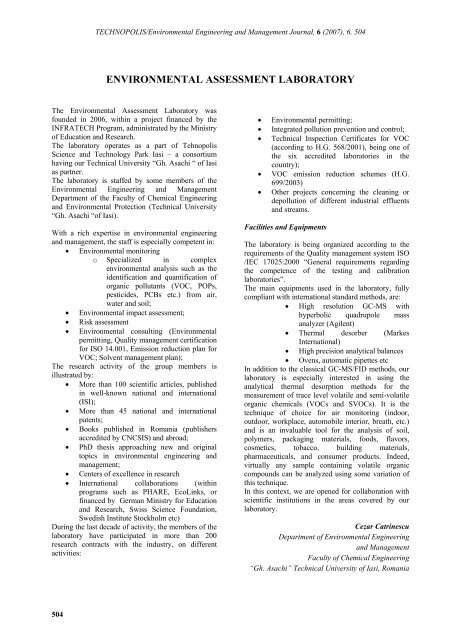2007_6_Nr6_EEMJ
You also want an ePaper? Increase the reach of your titles
YUMPU automatically turns print PDFs into web optimized ePapers that Google loves.
TECHNOPOLIS/Environmental Engineering and Management Journal, 6 (<strong>2007</strong>), 6, 504<br />
ENVIRONMENTAL ASSESSMENT LABORATORY<br />
The Environmental Assessment Laboratory was<br />
founded in 2006, within a project financed by the<br />
INFRATECH Program, administrated by the Ministry<br />
of Education and Research.<br />
The laboratory operates as a part of Tehnopolis<br />
Science and Technology Park Iasi – a consortium<br />
having our Technical University “Gh. Asachi “ of Iasi<br />
as partner.<br />
The laboratory is staffed by some members of the<br />
Environmental Engineering and Management<br />
Department of the Faculty of Chemical Engineering<br />
and Environmental Protection (Technical University<br />
“Gh. Asachi “of Iasi).<br />
With a rich expertise in environmental engineering<br />
and management, the staff is especially competent in:<br />
• Environmental monitoring<br />
o Specialized in complex<br />
environmental analysis such as the<br />
identification and quantification of<br />
organic pollutants (VOC, POPs,<br />
pesticides, PCBs etc.) from air,<br />
water and soil;<br />
• Environmental impact assessment;<br />
• Risk assessment<br />
• Environmental consulting (Environmental<br />
permitting, Quality management certification<br />
for ISO 14.001, Emission reduction plan for<br />
VOC; Solvent management plan);<br />
The research activity of the group members is<br />
illustrated by:<br />
• More than 100 scientific articles, published<br />
in well-known national and international<br />
(ISI);<br />
• More than 45 national and international<br />
patents;<br />
• Books published in Romania (publishers<br />
accredited by CNCSIS) and abroad;<br />
• PhD thesis approaching new and original<br />
topics in environmental engineering and<br />
management;<br />
• Centers of excellence in research<br />
• International collaborations (within<br />
programs such as PHARE, EcoLinks, or<br />
financed by German Ministry for Education<br />
and Research, Swiss Science Foundation,<br />
Swedish Institute Stockholm etc)<br />
During the last decade of activity, the members of the<br />
laboratory have participated in more than 200<br />
research contracts with the industry, on different<br />
activities:<br />
• Environmental permitting;<br />
• Integrated pollution prevention and control;<br />
• Technical Inspection Certificates for VOC<br />
(according to H.G. 568/2001), being one of<br />
the six accredited laboratories in the<br />
country);<br />
• VOC emission reduction schemes (H.G.<br />
699/2003)<br />
• Other projects concerning the cleaning or<br />
depollution of different industrial effluents<br />
and streams.<br />
Facilities and Equipments<br />
The laboratory is being organized according to the<br />
requirements of the Quality management system ISO<br />
/IEC 17025:2000 “General requirements regarding<br />
the competence of the testing and calibration<br />
laboratories”.<br />
The main equipments used in the laboratory, fully<br />
compliant with international standard methods, are:<br />
• High resolution GC-MS with<br />
hyperbolic quadrupole mass<br />
analyzer (Agilent)<br />
• Thermal desorber (Markes<br />
International)<br />
• High precision analytical balances<br />
• Ovens, automatic pipettes etc<br />
In addition to the classical GC-MS/FID methods, our<br />
laboratory is especially interested in using the<br />
analytical thermal desorption methods for the<br />
measurement of trace level volatile and semi-volatile<br />
organic chemicals (VOCs and SVOCs). It is the<br />
technique of choice for air monitoring (indoor,<br />
outdoor, workplace, automobile interior, breath, etc.)<br />
and is an invaluable tool for the analysis of soil,<br />
polymers, packaging materials, foods, flavors,<br />
cosmetics, tobacco, building materials,<br />
pharmaceuticals, and consumer products. Indeed,<br />
virtually any sample containing volatile organic<br />
compounds can be analyzed using some variation of<br />
this technique.<br />
In this context, we are opened for collaboration with<br />
scientific institutions in the areas covered by our<br />
laboratory.<br />
Cezar Catrinescu<br />
Department of Environmental Engineering<br />
and Management<br />
Faculty of Chemical Engineering<br />
“Gh. Asachi” Technical University of Iasi, Romania<br />
504


